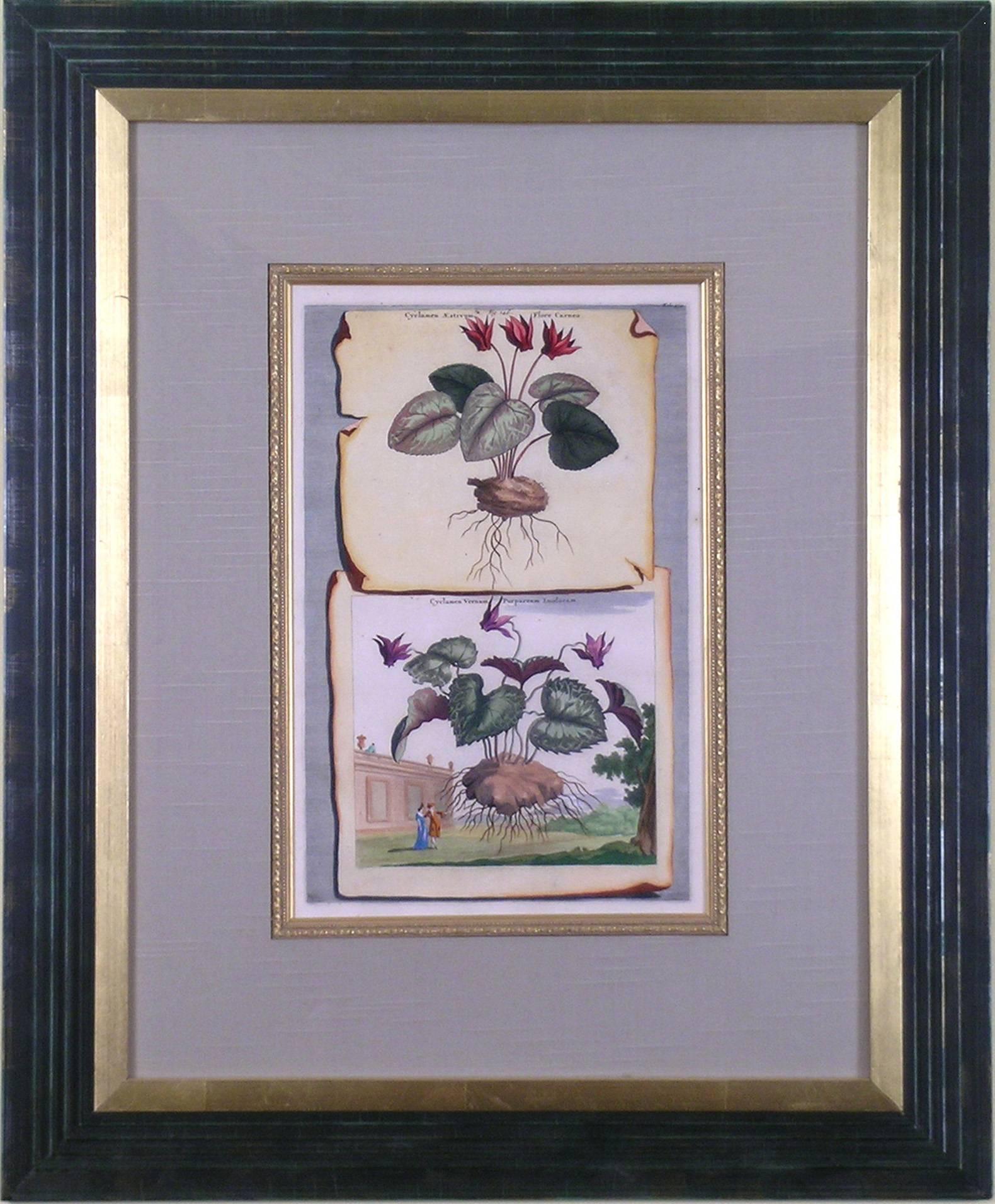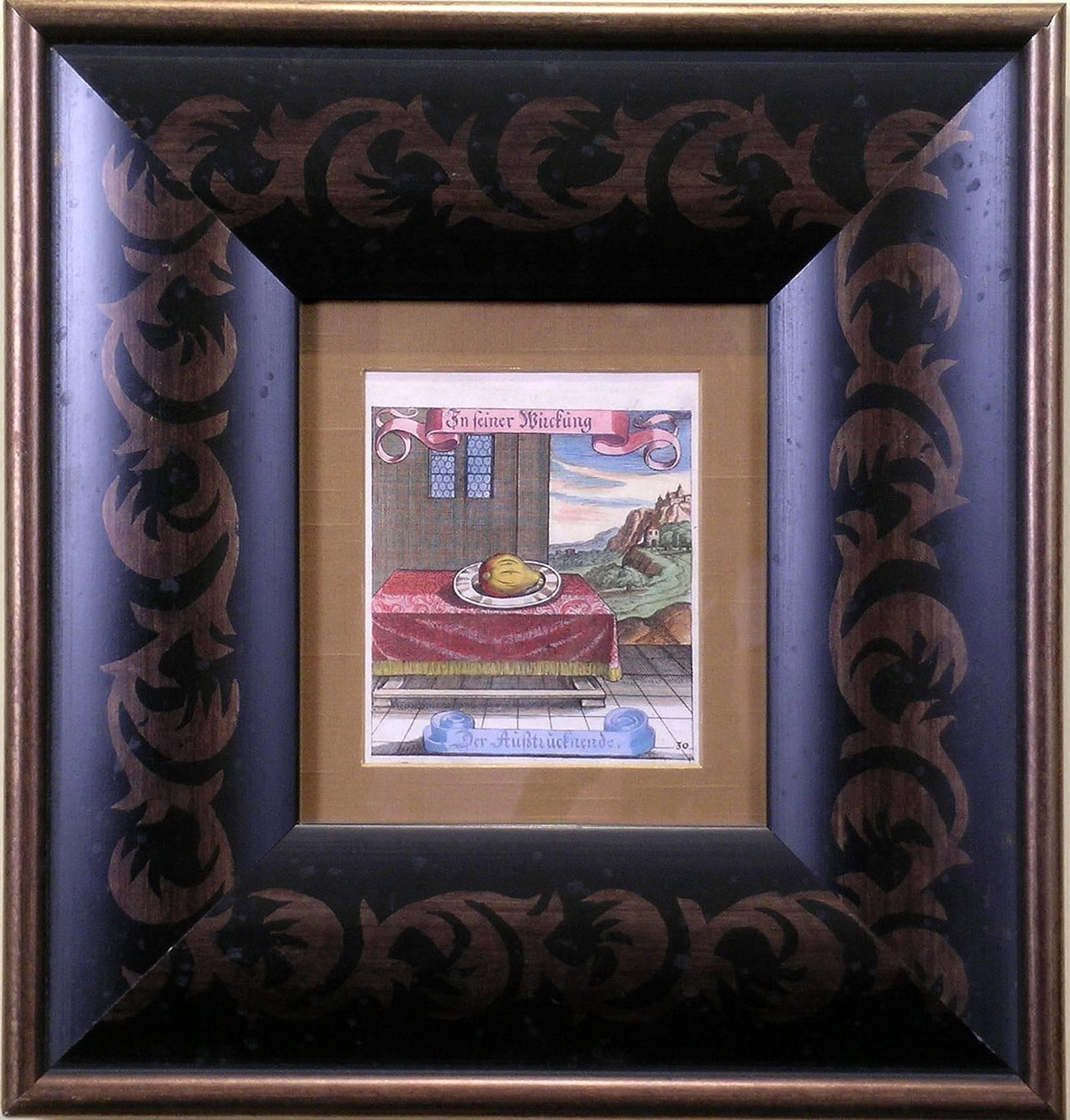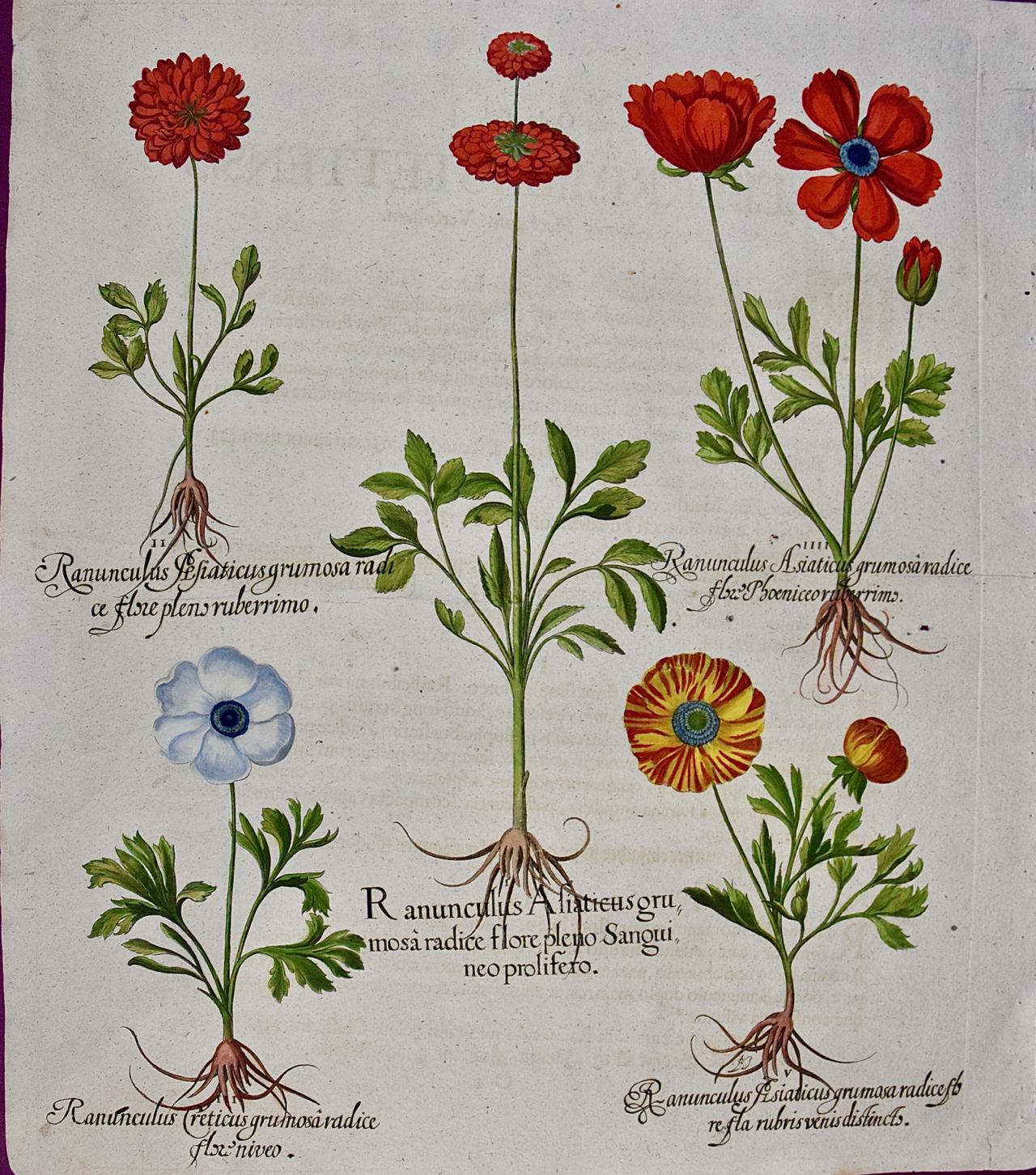Want more images or videos?
Request additional images or videos from the seller
1 of 7
Matthäus Merian the ElderBeans1646
1646
About the Item
MATTHAUS MERIAN, the Elder (1593-1650)
Der Fruchtbringenden Gesellschaft Nahmen.
Frankfurt, 1646.
Engraving with Later Hand-Color.
400 Plates. Image Size 4.5” x 5.25” Unframed.
Matthew Merian was one of the most prolifically published men of his time. Topography, cartography and botany were among his studies and he produced volumes in each subject. Each of his works is identifiable by intense detailing and an unerring sense of composition. Fond of architecture, Merian's works, if not completely dedicated to the subject, made use of the juxtaposition of his other studies against background or foreground scenes depicting the buildings and gardens he much loved to illustrate. Merian married botanist Theodore de Bry's daughter in Frankfurt in 1624 and also acquired his business. Merian produced de Bry's Florilegium Renovatum in 1641. A noted landscape artist and engraver, Merian was also the father of Maria Sibylla Merian, the noted entomologist and botanical artist. His son Matthew the Younger was a portrait painter, etcher and engraver who traveled in his youth to London, Paris, Italy and Nuremberg. Upon the death of Matthew the Elder, Matthew the Younger took over the management of his workshop which was renowned for producing engraved views and plans of European town and cities. Three generations of published illustrators!
In 1646, Merian produced small emblem plates in Der Fruchtbringenden Gesellschaft Nahmen. This was in fact Merian’s only florilegium. Although estimated to be among the finest seventeenth century herbals, it is remembered to day as one of the most beautifully engraved books ever produced. Each of the 400 emblems has a single flower, tree or fruit set against a delightfully detailed German town view of landscape background. This glorious work was originally intended for particular members of a society founded in Germany in 1617 whose objective was the promotion not only of human virtues, honesty and courtesy but also to support and improve the German language. From this rather unique endeavor, each member received a symbolic plant, flower, tree or bush with a scenic background personalized with the individuals own initials at the bottom of each page. Truly a gesture well suited to the academic climate of the times!
Reference: C. Nissen. Die Botanische. Stuggart, 1966
- Creator:Matthäus Merian the Elder (1593 - 1650, German)
- Creation Year:1646
- Dimensions:Height: 14.5 in (36.83 cm)Width: 13.75 in (34.93 cm)
- Medium:
- Movement & Style:
- Period:
- Condition:Clean, crisp image. Beautiful hand-coloring. Framed to museum specifications using archival matting, backing, and hinging. Raw silk matting with hand-painted bevel. Glazed with ultra-violet filtering Plexiglas.
- Gallery Location:Florham Park, NJ
- Reference Number:
About the Seller
5.0
Gold Seller
These expertly vetted sellers are highly rated and consistently exceed customer expectations.
1stDibs seller since 2014
161 sales on 1stDibs
Typical response time: 3 hours
- ShippingRetrieving quote...Ships From: Florham Park, NJ
- Return PolicyA return for this item may be initiated within 1 day of delivery.
More From This SellerView All
- Cyclamen (Purple)By Abraham MuntingLocated in Florham Park, NJAbraham Munting (1626 – 1683) Naauwkeurige Beschryving der Aardgewassen Leiden and Ultrech, Germany, 1696 Publishers: Pieter vander Aa and Francois Halma Folio, 15 ¼ “ x 10 ¼ “ ...Category
18th Century and Earlier Academic Still-life Prints
MaterialsEngraving, Watercolor
- Cyclamen (White)By Abraham MuntingLocated in Florham Park, NJAbraham Munting (1626 – 1683) Naauwkeurige Beschryving der Aardgewassen Leiden and Ultrech, Germany, 1696 Publishers: Pieter vander Aa and Francois Halma Folio, 15 ¼ “ x 10 ¼ “ ...Category
18th Century and Earlier Academic Still-life Prints
MaterialsEngraving, Watercolor
- SquashBy Matthäus Merian the ElderLocated in Florham Park, NJMATTHAUS MERIAN, the Elder (1593-1650) Der Fruchtbringenden Gesellschaft Nahmen. Frankfurt, 1646. Engraving with Later Hand-Color. Matthew Merian was one of the most prolifica...Category
18th Century and Earlier Academic Still-life Prints
MaterialsEngraving, Watercolor
- WalnutBy Matthäus Merian the ElderLocated in Florham Park, NJMATTHAUS MERIAN, the Elder (1593-1650) Der Fruchtbringenden Gesellschaft Nahmen. Frankfurt, 1646. Engraving with Later Hand-Color. 400 Plates. Image Size 4.5” x 5.25” Unframed. ...Category
18th Century and Earlier Academic Still-life Prints
MaterialsEngraving, Watercolor
- Dish GardenLocated in Florham Park, NJDish Garden in Blue and White China Japanese Woodblock Original Hand-color. Meji Period. Circa 1895. The enthusiasm for nature prints has spanned the centuries. By the mid-nineteenth century these works, illustrating varieties of flowers in naturalistic styles, had reached a peak of perfection. Each artistic form in traditional printing sought to enhance the beauty of botany. In the woodblock style, as it true for engravings and lithographs, it is imperative that the carving of each block be exacting as they must create an image true to that seen in nature. For many, the dish garden is a re-creation of a favorite landscape design. It provides an opportunity to build a perfect pairing of ornament...Category
Late 19th Century Academic Still-life Prints
MaterialsWatercolor, Woodcut
- N. 66 Aloe Tuberosa LevisBy Johann Wilhelm WeinmannLocated in Florham Park, NJJOHANN WILHELM WEINMANN. Phytanthoza Iconographia…. Published by Raisbonae. Regensburg, 1735-47. Engraved by J.J. Haid, J.E. Ridinger, B. Seuter and G.D. Ehret. Hand-colored mezzotin...Category
18th Century and Earlier Academic Still-life Prints
MaterialsGold Leaf
You May Also Like
- Buttercup Flowers: A Besler 18th Century Hand-colored Botanical EngravingLocated in Alamo, CAThis is a hand-colored copper plate engraving depicting Ranunculus (Persian Buttercup) flowers from Basilius Besler's landmark work, Hortus Eystettensis (Garden at Eichstatt), first ...Category
Early 18th Century Academic Still-life Prints
MaterialsEngraving
- Papaya and Moth Metamorphosis: 18th C. Hand-colored Engraving by Maria MerianBy Maria Sibylla MerianLocated in Alamo, CAThis exquisite hand-colored 18th century folio-sized engraving of a papaya plant and moth metamorphosis is plate 64 from Maria Sibylla Merian's publication '...Category
Early 18th Century Academic Still-life Prints
MaterialsEngraving
- Flowering Iris & Other Botanicals: Framed 17th C. Besler Hand-colored EngravingLocated in Alamo, CAThis is a hand-colored copper-plate engraving entitled "I. Spatula foetida - II. Caucalis Dodonei - III. Cruciata", depicting three flowering plants, including an Iris, from Basilius Besler's landmark work, Hortus Eystettensis (Garden at Eichstatt), first published in 1613 in Eichstatt, Germany near Nuremberg and later in 1640 and 1713. This beautiful hand-colored botanical engraving is presented in a gold-colored wood frame with a French mat...Category
Mid-17th Century Academic Still-life Prints
MaterialsEngraving
- Hand-colored 1834 Joseph Paxton Botanical Engraving of Yellow Trumpet FlowersBy Joseph PaxtonLocated in Alamo, CAA hand-colored engraving of yellow trumpet flowers from Sir Joseph Paxton's (1803-1865) "Magazine of Botany and Register of Flowering Plants", published in 1834. This engraving entit...Category
Early 19th Century Academic Figurative Prints
MaterialsEngraving
- A 19th century Colored Botanical Engraving of Flowers by CzeigerLocated in Alamo, CAA colored 19th century botanical engraving of flowers by Anstalt S. Czeiger of Vienna, Austria. An inscription at the bottom includes: "Wien, Kai...Category
Late 19th Century Academic Figurative Prints
MaterialsEngraving
- Flowering Feverfew Plants: A 17th C. Besler Hand-colored Botanical EngravingLocated in Alamo, CAThis is a hand-colored copper plate engraving entitled "Matricaria Flore Simplici, Matricaria Flore Pleno, depicting flowering Feverfew and Double-flowered Feverfew plants, from Basilius Besler's landmark work, Hortus Eystettensis (Garden at Eichstatt), first published in 1613 in Eichstatt, Germany near Nuremberg and later in 1640 and 1713. The feverfew plant is also known as featherfew, featherfoil, or bachelor’s buttons...Category
1640s Academic Still-life Prints
MaterialsEngraving
Recently Viewed
View AllMore Ways To Browse
The Bean
Mens Black Suit
Small Botanical Print
Set Of Architectural Engravings
Black Bean
Mens Printed Suits
The Virtues Prints
Fruit Plates German
Portrait German 18th Century
18th Century Botanical Plate
Botanical Engravings Set
Engraving Garden Building
Botanical Plate Set
Set Of Botanical Engravings
18th C Still Life
Antique Merian Prints
Small 18th Century Still Life
Merian Engraving





